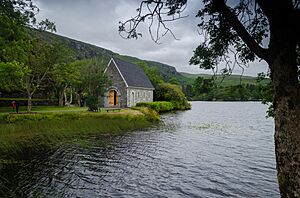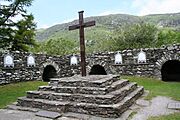Gougane Barra facts for kids
Quick facts for kids
Gougane Barra
Guagán Barra
|
|
|---|---|
|
Settlement
|
|

Gougane Barra oratory
|
|
| Country | Ireland |
| Province | Munster |
| County | County Cork |
Gougane Barra is a very scenic valley and a special historical place in County Cork, Ireland. Its name, Guagán Barra, means "the rock-cleft of Barra" in Irish. This beautiful spot is located in the Shehy Mountains, near the village of Ballingeary. It is also where the River Lee starts its journey. Gougane Barra is famous for its peaceful lake, which has a small island with an old church building called an oratory. There is also a large forest park here.
Contents
History of Gougane Barra
Gougane Barra gets its name from Saint Finnbarr, also known as Barra. People believe that Saint Finnbarr built a monastery on the lake's island way back in the sixth century. This was a place where monks lived and prayed.
The Hermitage and Penal Laws
The old stone ruins you can see on the island today are from a hermitage built around the year 1700. A priest named Denis O'Mahony came to live a quiet, religious life on the island.
During a time in Irish history called the Penal Laws, it was very difficult for Roman Catholic people to practice their religion openly. Because Gougane Barra was so remote and hidden away, it became a safe and popular place for people to gather and celebrate Mass.
St Finbar's Oratory
The beautiful oratory that stands near the old hermitage today was built in the 1800s. It is well-known for its stunning location and lovely decorations inside. Many people choose this picturesque spot for wedding photos.
Gougane Barra is also the end point for one of Ireland's five Pilgrim Paths of Ireland. This path, called St Finbar's Pilgrim Path, starts 35 kilometres away in a place called Drimoleague.
Gougane Barra Forest Park
The reforestation of Gougane Barra began in 1938. Today, it is a large forest park covering about 1.42 square kilometres. This park is home to twenty different types of trees. Many of these are not native to Ireland, like Sitka spruce, Japanese larch, and Lodgepole pine. However, you can also find native trees like Scots pine and other local plants and animals.
The River Lee begins its journey in the hills above the park and flows into Gougane lake. The forest park has 5 kilometres of trails for cars and 10 kilometres of walking paths through the hills. These paths offer great views and lead to interesting nature spots.
In 2014, the forest, which is owned by Coillte, had to close for a while. This was because about 16,000 trees, mostly larches, were sick with a tree disease called Phytophthora ramorum. These sick trees had to be cut down. The plan was to replace them with native trees like oak and Scots pine.
Wind Farm Plans
Since 2021, a company called Wingleaf Ltd has been planning to build a wind farm in the Gougane Barra area. This would involve putting up seven very tall wind turbines, which would be among the tallest in Ireland.
Local Opposition
Many local people and groups were against this plan. The Cork County Council, which is the local government, voted completely against the wind farm. They refused permission for it to be built.
However, the company appealed this decision to An Bord Pleanála, which is Ireland's national planning board. Even though their own inspector also said the wind farm should not be built, An Bord Pleanála decided to allow it. They said the wind farm would help Ireland meet its goals for renewable energy.
Tim Lucey, a spokesperson for the people who were against the wind farm, said that this decision was unfair. He felt it was "undemocratic" because the local people and their council were against the project, but it was still approved.
Gallery





